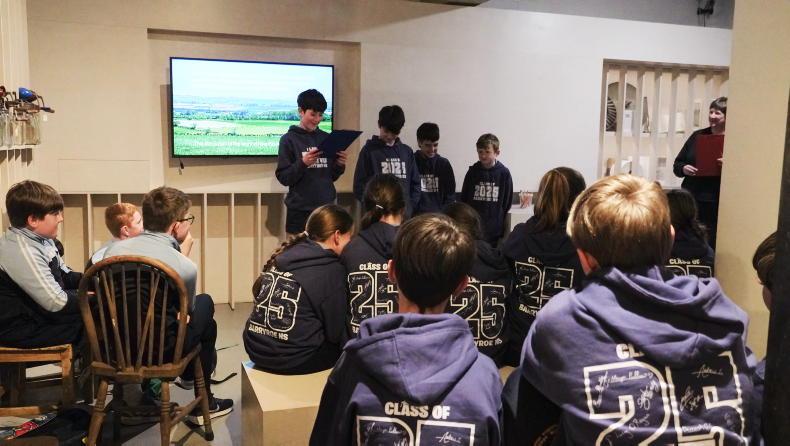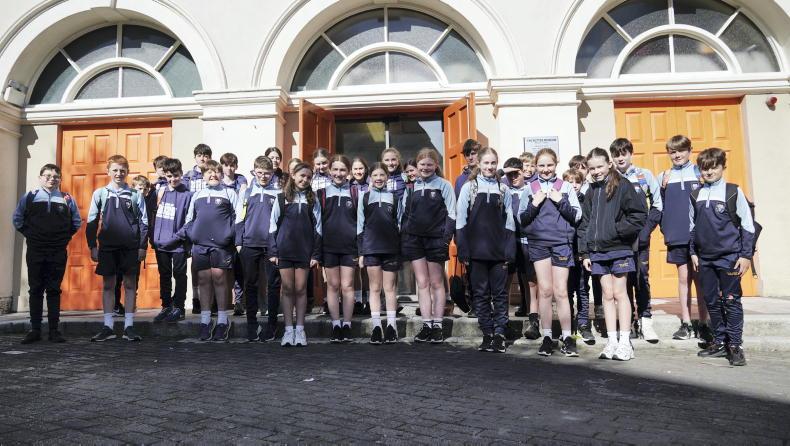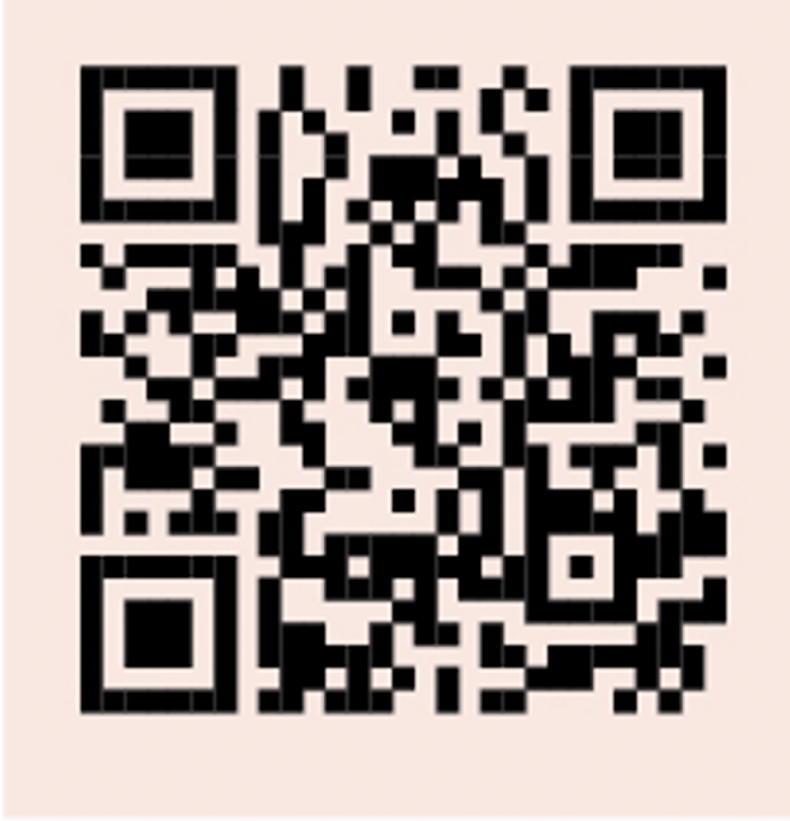Two west Cork national schools, Ardfield NS and Barryroe NS, recently took part in a new initiative with The Butter Museum in Cork city. Backed by the Golden Jubilee Trust, the project was part of the centenary celebrations of two of the regions four dairy co-operatives, Lisavaird and Barryroe.
Danielle O’Toole from The Butter Museum was part of the celebrations and explains to Irish Country Living what was involved.
“This was a chance to reconnect the kids with butter-making and farming heritage and the idea that milking and making butter at home was part of everyday life. Farmers visited the school to speak about it and we got to make butter in the classroom using methods people used 150 years ago,” she says.
“We also looked for townlands or places with names with a farming connection using the logainm.ie website. In Ardfield, one townland near the school is called Dairies, that was self-explanatory but for others we had to look at the old Irish names like, Moneennamucky (small bogland of the pig) and Muckross (wooded height of the pig),” continues Danielle.
“They learned that cattle were kept in ringforts or dún’s, and there was a number of place names like Dundeady (Deady’s fort), Dunowen (Owen’s fort) and Dunnycove (Cowhigs fort) in the parish. The students were fascinated about the cattle raiding that took place long ago.
“In Barryroe, we used the old Ordnance Survey maps to look at the locality from the 1800s. The students discovered themselves, that you could overlay the current satellite images on the old maps and were able to see how it changed over time.”
Ardfield National School
Local dairy farmer and historian, Tim Feen paid a visit to Ardfield NS.
“When I was younger you could count 16 or 17 milk suppliers a short distance from our yard. Now the closest one is a mile away.
“I remember going to the creamery every day when I was young. The children couldn’t believe the milk was carried there by horses and carts or even how the milk was cooled. When refrigeration improved, we went from every day to every second day, and then the milk lorries started collecting in the 1970s.
“When you dropped the milk off, it would be separated and you’d get the skim milk back and you’d bring that home to feed to the pigs. It was all manual handling back then too.
“It was very much of a social thing too. There was great craic in the creamery back then and some people might give half a day there chatting. There was the odd row too if someone jumped the queue,” says Tim, laughing.
Jacob Deady Fitzgerald, fifth class: “I liked making the butter, that was really fun. You start with the milk and then you shake that until it becomes cream. You keep shaking in a jar that’s not too full, until it becomes like whipped cream. Then you get these things called scotch hands. They’re like spoons but they’re flat and have lines.
“You take the whipped cream out and get all the buttermilk out and you put it back in the jar and keep shaking it and add salt and you have butter.”
Hannah McCarthy, fifth class: "I found the bog butter really surprising. The fact that people buried butter hundreds of years ago and that people still find it nowadays – that’s amazing.
“We learned about cattle raiding too and how people would go around stealing other people’s cattle and I found it interesting that people used to store their cattle in ring forts."

Pupils from Barryroe National School visiting The Butter Museum.
Donagh Calnan, sixth class: “My favourite thing I saw in The Butter Museum was the ink stamps and butter wrappers they used all through the years. What most surprised me is that cows were stolen from their pens for their milk. Lisavaird Co-op was the first place to take milk in the parish. I was amazed that they brought the milk from the country into the heart of the city to make butter for the people of Cork in churns."
James O’Shea, sixth class: "My favourite part of The Butter Museum was making the butter. What surprised me the most was that cattle raiding was a very common thing long long ago. I also never knew that butter was made in Lisavaird Co-op. My Nana has worked there since 1980."
Ryan Whelton, sixth class: "My favourite part was learning that my grandad used to bring the milk he produced to the creamery until he got a refrigerated tank. Tim Feen told us too that when the creamery closed for making butter that the local farmers were able to keep something from there as a memento. I was surprised to learn that there are lots of place names in Ardfield connected with farming."
Barryroe National School
Local farmer, John O’Brien is someone with a long connection with Barryroe Co-op and with the wider dairy sector in Ireland too. He visited Barryroe NS as part of the project.
“When I was in school, Barryroe Co-op celebrated 50 years and when it celebrates 150 years some of these students will remember the centenary. It creates a connection and they are part of the living history.
“We looked at the centenary calendar and they were able to spot their grandparents and learn how milk was supplied before. One student, their great grandfather was a cheese and butter maker there.
“I’m always enthused about the whole geography and history of our locality and country that centres around dairy and butter.
“The co-ops survived and there’s a great life in the area because of them. Some of the pupils I met with may get summer jobs and some might get careers out of working in Barryroe Co-op in future,” John says.

Students from Barryroe National School in west Cork pictured visiting the Butter Museum in Cork city.
Michael Harrington, fifth class: “I loved visiting The Butter Museum with my classmates. I learned that butter was ‘yellow gold’ and roads were just made for transporting butter. This piece of fabulous dairy made the rebel county rich. I was surprised that firkins were really heavy and horses could only hold two.”
Aron O’Sullivan, fifth class: “I loved visiting The Butter Museum and with the sound of the Shandon Bells ringing in my ears I learned that the butter made in Cork was exported all over the world.”
Alex Daly, sixth class: “Johnny Brien, a local farmer and Danielle from the Butter Museum came to our school and I learned about my great-grandad Michael Coppinger, who was a scientist in the Barryroe Co-op.
“The local people talk a lot about how he revolutionised the co-op industry and helped the co-op here move forward. My favourite part about the museum was looking at the pictures and memorabilia.”
Vlada Berdysheva, sixth class: My favourite part was making the butter. There was milk in a jar and we had to shake it until it looked like scrambled eggs. Next we had to squeeze all the excess liquid out. We made a cube out of the butter and stamped it with a special logo. The best part – we got to eat it on fresh bread.”
Kate Gresham, sixth class: My favourite part was seeing the different churns and butter wrappers. Seeing the ‘Maid of Ibane’ wrapper on the wall in the museum was special. I can’t believe they made roads just to transport butter. I was surprised to learn about bog butter and the fact that it was so old.
“I learned about all the people who worked in my local area of Barryroe and the co-op connected them. They worked hard to make and transport butter.”
See thebuttermuseum.com
Scan the QR code below and take a step back in time to see the milk being taken to the creamery in Ardfield by horse and cart in July 1956.

Two west Cork national schools, Ardfield NS and Barryroe NS, recently took part in a new initiative with The Butter Museum in Cork city. Backed by the Golden Jubilee Trust, the project was part of the centenary celebrations of two of the regions four dairy co-operatives, Lisavaird and Barryroe.
Danielle O’Toole from The Butter Museum was part of the celebrations and explains to Irish Country Living what was involved.
“This was a chance to reconnect the kids with butter-making and farming heritage and the idea that milking and making butter at home was part of everyday life. Farmers visited the school to speak about it and we got to make butter in the classroom using methods people used 150 years ago,” she says.
“We also looked for townlands or places with names with a farming connection using the logainm.ie website. In Ardfield, one townland near the school is called Dairies, that was self-explanatory but for others we had to look at the old Irish names like, Moneennamucky (small bogland of the pig) and Muckross (wooded height of the pig),” continues Danielle.
“They learned that cattle were kept in ringforts or dún’s, and there was a number of place names like Dundeady (Deady’s fort), Dunowen (Owen’s fort) and Dunnycove (Cowhigs fort) in the parish. The students were fascinated about the cattle raiding that took place long ago.
“In Barryroe, we used the old Ordnance Survey maps to look at the locality from the 1800s. The students discovered themselves, that you could overlay the current satellite images on the old maps and were able to see how it changed over time.”
Ardfield National School
Local dairy farmer and historian, Tim Feen paid a visit to Ardfield NS.
“When I was younger you could count 16 or 17 milk suppliers a short distance from our yard. Now the closest one is a mile away.
“I remember going to the creamery every day when I was young. The children couldn’t believe the milk was carried there by horses and carts or even how the milk was cooled. When refrigeration improved, we went from every day to every second day, and then the milk lorries started collecting in the 1970s.
“When you dropped the milk off, it would be separated and you’d get the skim milk back and you’d bring that home to feed to the pigs. It was all manual handling back then too.
“It was very much of a social thing too. There was great craic in the creamery back then and some people might give half a day there chatting. There was the odd row too if someone jumped the queue,” says Tim, laughing.
Jacob Deady Fitzgerald, fifth class: “I liked making the butter, that was really fun. You start with the milk and then you shake that until it becomes cream. You keep shaking in a jar that’s not too full, until it becomes like whipped cream. Then you get these things called scotch hands. They’re like spoons but they’re flat and have lines.
“You take the whipped cream out and get all the buttermilk out and you put it back in the jar and keep shaking it and add salt and you have butter.”
Hannah McCarthy, fifth class: "I found the bog butter really surprising. The fact that people buried butter hundreds of years ago and that people still find it nowadays – that’s amazing.
“We learned about cattle raiding too and how people would go around stealing other people’s cattle and I found it interesting that people used to store their cattle in ring forts."

Pupils from Barryroe National School visiting The Butter Museum.
Donagh Calnan, sixth class: “My favourite thing I saw in The Butter Museum was the ink stamps and butter wrappers they used all through the years. What most surprised me is that cows were stolen from their pens for their milk. Lisavaird Co-op was the first place to take milk in the parish. I was amazed that they brought the milk from the country into the heart of the city to make butter for the people of Cork in churns."
James O’Shea, sixth class: "My favourite part of The Butter Museum was making the butter. What surprised me the most was that cattle raiding was a very common thing long long ago. I also never knew that butter was made in Lisavaird Co-op. My Nana has worked there since 1980."
Ryan Whelton, sixth class: "My favourite part was learning that my grandad used to bring the milk he produced to the creamery until he got a refrigerated tank. Tim Feen told us too that when the creamery closed for making butter that the local farmers were able to keep something from there as a memento. I was surprised to learn that there are lots of place names in Ardfield connected with farming."
Barryroe National School
Local farmer, John O’Brien is someone with a long connection with Barryroe Co-op and with the wider dairy sector in Ireland too. He visited Barryroe NS as part of the project.
“When I was in school, Barryroe Co-op celebrated 50 years and when it celebrates 150 years some of these students will remember the centenary. It creates a connection and they are part of the living history.
“We looked at the centenary calendar and they were able to spot their grandparents and learn how milk was supplied before. One student, their great grandfather was a cheese and butter maker there.
“I’m always enthused about the whole geography and history of our locality and country that centres around dairy and butter.
“The co-ops survived and there’s a great life in the area because of them. Some of the pupils I met with may get summer jobs and some might get careers out of working in Barryroe Co-op in future,” John says.

Students from Barryroe National School in west Cork pictured visiting the Butter Museum in Cork city.
Michael Harrington, fifth class: “I loved visiting The Butter Museum with my classmates. I learned that butter was ‘yellow gold’ and roads were just made for transporting butter. This piece of fabulous dairy made the rebel county rich. I was surprised that firkins were really heavy and horses could only hold two.”
Aron O’Sullivan, fifth class: “I loved visiting The Butter Museum and with the sound of the Shandon Bells ringing in my ears I learned that the butter made in Cork was exported all over the world.”
Alex Daly, sixth class: “Johnny Brien, a local farmer and Danielle from the Butter Museum came to our school and I learned about my great-grandad Michael Coppinger, who was a scientist in the Barryroe Co-op.
“The local people talk a lot about how he revolutionised the co-op industry and helped the co-op here move forward. My favourite part about the museum was looking at the pictures and memorabilia.”
Vlada Berdysheva, sixth class: My favourite part was making the butter. There was milk in a jar and we had to shake it until it looked like scrambled eggs. Next we had to squeeze all the excess liquid out. We made a cube out of the butter and stamped it with a special logo. The best part – we got to eat it on fresh bread.”
Kate Gresham, sixth class: My favourite part was seeing the different churns and butter wrappers. Seeing the ‘Maid of Ibane’ wrapper on the wall in the museum was special. I can’t believe they made roads just to transport butter. I was surprised to learn about bog butter and the fact that it was so old.
“I learned about all the people who worked in my local area of Barryroe and the co-op connected them. They worked hard to make and transport butter.”
See thebuttermuseum.com
Scan the QR code below and take a step back in time to see the milk being taken to the creamery in Ardfield by horse and cart in July 1956.










 This is a subscriber-only article
This is a subscriber-only article










SHARING OPTIONS: